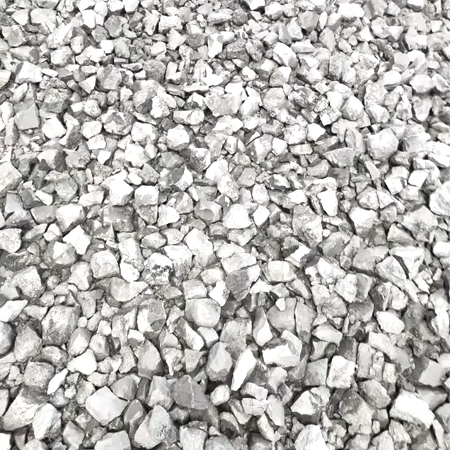Low silicon ferrosilicon is a ferrosilicon alloy with a low silicon content. It has other names such as Low Ferrosilicon, Low Silicon FeSi, low Si FeSi, etc. No matter which name, It commonly referring to an iron-silicon alloy with silicon content between 10% and 35%. We should note that although the names are similar, it is quite different from Low Aluminum Ferrosilicon. Low silicon ferrosilicon has important applications in the metallurgical industry, especially in the smelting process of special steels.
| Model No. | Chemical Composition (%) | |||||||
| Si | C | Al | S | P | ||||
| ≥ | ≤ | |||||||
| Si 15 | 15-20 | 2.0 | 2.0 | 0.1 | 0.2 | |||
| Si 25 | 25-30 | 1.5 | 2.0 | 0.02 | 0.05 | |||
| Si 45 | 45 | 0.5 | 2.0 | 0.02 | 0.05 | |||
Characteristics of Low Silicon Ferrosilicon
The important component of low silicon ferrosilicon is silicon, which generally contains 10%-30%. Iron is the largest element, generally the remainder except silicon. In addition to silicon and iron, low silicon ferrosilicon also contains impurity elements such as carbon, aluminum, sulfur, and phosphorus. Generally these other impurity elements do not exceed 5% in total.

Low-Si ferrosilicon (usually 10%-15% silicon content) is a useful material in steel smelting and casting industries. It is an efficient deoxidizer in steelmaking, which can effectively reduce the oxygen content in molten steel and improve the quality of steel; in the casting field, it can be an inoculant to improve the cast iron structure, promote graphite spheroidization, and enhance the mechanical properties of castings. In addition, it is also useful in special purposes such as reducing agent in magnesium smelting, additive in welding rod production and suspension medium in mineral processing industry. With its stable chemical properties and controllable silicon content, it plays a key role in special steel production and precision casting.
2 Types of Low Ferrosilicon
Specifically, there are two types of low silicon ferrosilicon. One with a silicon content between 10-20%, which is made from electric furnace smelting. The main raw materials are iron ore, silica and high-quality coke, producing by reduction reaction at 1500-1650℃. Its silicon content is adjustable by the proportion of raw materials such as silica and the reduction conditions.
The other type of low silicon ferrosilicon is mainly a by-product from calcium carbide iron slag. Calcium carbide iron slag mainly comes from the production process of calcium carbide. It contains various elements such as iron, silicon, and carbon. Its specific content varies depending on the production process and raw materials. Calcium carbide slag iron is generally gray-black or dark brown, with a certain hardness and brittleness. Because it contains a high iron content, it has a certain magnetic property. After washing and sorting, we can obtain low-silicon ferrosilicon containing 20-35% si content. Its iron content is generally between 60-75%, and the impurity content is close to that of ordinary ferrosilicon.
Differences of Low Silicon FeSi and Regular Ferrosilicon
The main differences between low-silicon FeSi (silicon content 10%~15%) and ordinary FeSi (Si content 45%~75%) are composition, use and characteristics. Low-silicon FeSi is mainly iron, with a high melting point (1300~1400℃), high density, mild deoxidation, and is suitable for precise control of silicon content in steelmaking. Also, it has low cost, just like silicon slag. Ordinary ferrosilicon has a high silicon content and stronger deoxidation and alloying capabilities. High-silicon grades (such as FeSi75) can also be used for magnesium smelting. In production, low-si fesi uses low-grade silica or iron filings, with lower energy consumption; ordinary ferrosilicon requires high-purity silica, which consumes more energy. When choosing, it is necessary to consider the steel grade requirements (such as deoxidation accuracy or silicon alloying) and cost comprehensively.
